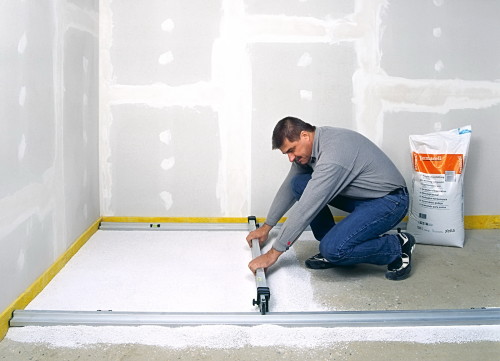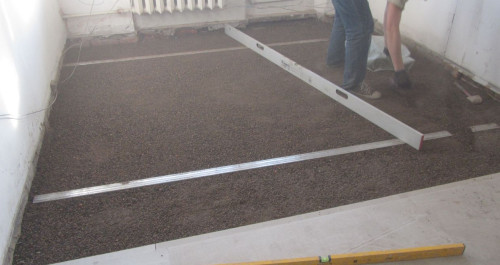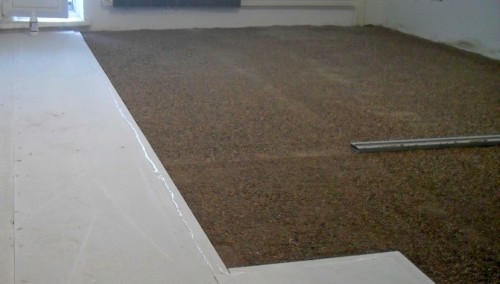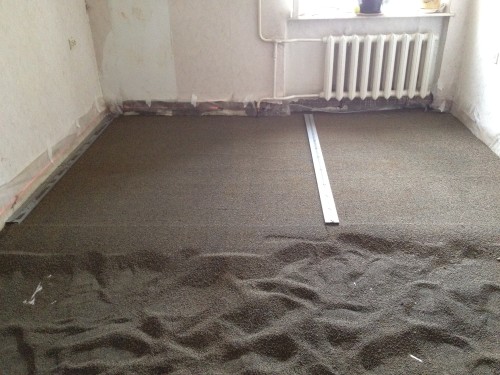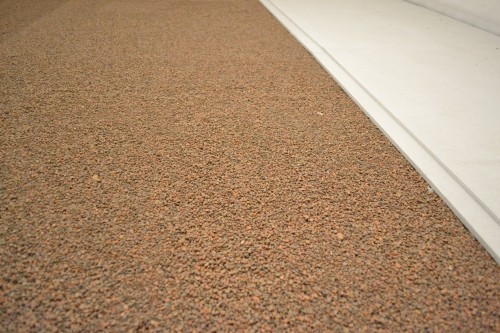
Dry screed with your own hands Floors
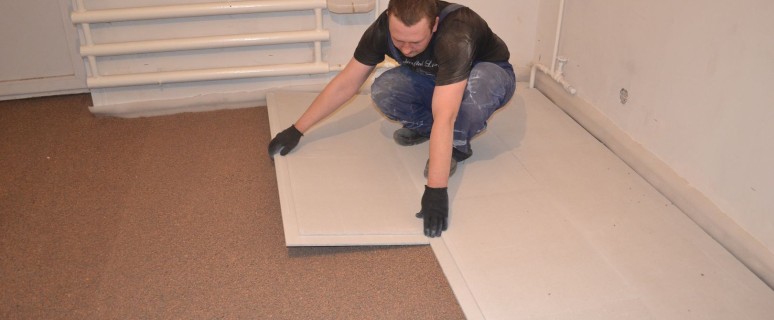
The creation of a floor screed is not easy, and often the owners are fully relying on the professionalism of third-party workers who need to pay a considerable amount for the work done. It is worth noting the fact that the bulk screed actually has a number of important features that should be paid to those people who practically have no experience in building business. Practice shows that even the most minor at the first view of the moments associated with the technology of creating a dry screed, later be sure to be felt. Error assumption will definitely become apparent, and then it will take full-fledged restoration work, or a general coating replacement.
Content
Recently, a dry screed is used in ordinary residential buildings and apartments instead of wet. Two these ties are quite comparable in quality and durability, but some problems still have a place. We are talking about technology that often turns out to be quite complicated, especially if the worker has no similar experience. Fortunately, you can easily explore every step of these works and make some conclusions that will allow you to perfectly carry out the repair process and get a flat floor.
In this article we will try to consider the most important features of the dry screed, as well as analyze the entire surface creation process. Also, we will not leave the most details that can significantly affect the end result. It is most important in this business to be attentive, as well as to have at least one assistant who will help in difficult moments, or will notice those details that are not always striking.
Features of a dry screed
Dry screed is actively used not only in private houses and apartments, but also on a variety of other sites. Of course, this type of screed is not universal, but many advantages still has. It can be noted that the dry screed becomes the basis for garage premises and the like spaces. Surely the most owners in the dry tie attracts the fact that for the full use of the surface you do not need to wait a lot of time after the fill, as it happens with a wet material. Accordingly, this is a sufficiently short repair process, which, besides, will not require too much financial spending.
It is best to consider the main advantages and disadvantages of a dry screed, and the "dry floor of Knauf" will be considered as the main material.
Advantages of dry screed:
- No dust and dirt. Creating a cement screed of the hosts is almost doomed to completely stain, as well as spread dust throughout the dwelling. This brings many inconveniences and problems, but this can be easily avoided, using a dry tie. If we are talking about a classic dry tie, then a certain layer of bulk material is meant, as well as the surface of gypsum fiber sheets. It is worth paying attention to the fact that today there is actually an extensive range of dry ties, so you can choose exactly what is most suitable for available space. In the case of a wet tie, there are practically no alternatives and can not be. Especially bad when the cement flows, and somehow you need to quickly correct the situation. With such a situation, you can gain a lot of problems, including and financial losses are not excluded if the concrete is already unsuitable for use.
- Noise insulation. Many owners create additional coverage to ensure the most optimal protection against noise. At the same time, it is worth paying attention to the fact that when using a dry screed, we get canceled noise insulation without the use of additional resources. It is interesting that it is the dry screed that is able to make serious competition with relevant materials used exclusively to reduce external noise. Together with the noise insulation of the walls, the room will actually become comfortable, even if the window has a lot of transport.
- Versatility. Previously, we focused on the fact that the dry tie can be used far from all the premises, but it can be laid on most surfaces. Accordingly, we are talking about reinforced concrete bases, concrete slabs and even wooden floors on the lags. Accordingly, any owner may not thinking to acquire this screed and lay it on the surface, even if the floor has specific damage or other flaws. In any case, advice will not prevent specialists who quickly analyze the situation and give a good advice.
- Quick installation. We talked about the wet screed - this is a fairly long process that takes a lot of energy and forces from the workers, so also concrete gains strength for several weeks. The best way out of this situation is the use of a dry screed. Representatives of large companies that make ties indicate that the process of arranging a dry screed often occurs from 10 to 16 hours (depending on the existing space). This is a truly short period of time, but the best news is that after installing gypsum fiber sheets, the room can be fully operated. This can not but rejoice, especially considering a practically monolithic surface, which is not inferior to the wet tie. Within the framework of a small room, create a dry screed can be extremely fast, and even without assistance.
- Small load on the overlap. The wet screed has simply grace weight, and sometimes a layer of cement negatively affects the overall construction construction. Because of this building, it may begin to deform, as well as cracked. In turn, the dry screed does not create any such problems, so you can safely carry out similar repair work even on a large scale. Dry backfills that are often used for this process have a modest weight, despite the fact that the overall layer of material can be quite impressive. Accordingly, all aspects of safety associated with the load on the overlap are taken into account.
- Warm floor. Often the created dry screed is characterized by a rather warm coating, all this is achieved due to dry swelling, which are able to keep even the minimum heat that is in the room. Thus, if there is at least a small insulation in the dwelling, the floor will also give itself to know from the best side. Comprehensive insulation of the room or housing will be most effective with a dry tie.
- Lack of wet processes. Due to the fact that in the process of creating a dry screed, cement and other wet components do not need to use, the process is significantly simplified and accelerated. Thus, one factor combines 2 important characteristics, which for most owners will be decisive when choosing a screed.
Despite such a large list of strengths of a dry screed, you can allocate many other aspects, but already smaller. For example, the ease of transportation of building components is a fairly relevant issue.
The main disadvantage associated with the dry screed is the fear of moisture. Thus, if a leak will occur on the floor of the floor, or there will simply affect the vague pairs, the screed will be extremely fast. Hypus fiber sheets used in the screed gradually swell. After that, it will be almost impossible to return the source state of the material. Experts recommend creating dry ties only in those places where there is no threat of water to the surface.
- It is important to keep in mind that the couples that were previously stated, appear from the lower rooms or from concrete overlap. Sometimes the problem originates from wet walls. In order for the ridiculous accident, the specialists are recommended to install the steam insulation layer on the overlap. In addition, there are many other layers with which you can avoid troubles related to moisture. In a concrete case, it is most important to protect the screed back from moisture.
- In the event that there is no desire to use expensive insulation materials, you can make a choice in favor of the most ordinary polyethylene film. In other cases, parchment or bituminized paper will fit.
Choosing a dry tie
It should be remembered that now there are many manufacturers producing dry tie. Of course, it is advisable to make a choice in favor of eminent companies that have already managed to select most of the building materials market. Of course, the most famous representative of the market is Knauf, which produces exceptionally high-quality construction resources. Often, it is often from this manufacturer to find the following types of dry ties:
- Alpha. This version of the screed is best suited for repair work on a flat surface without flaws.
- Beta. This option is used by a layer of effective insulating materials with a flat surface.
- Vega. Based on the leveling floor with filling.
- Gamma. According to the layer of effective heat and sound insulation materials, as well as on the layer of dry backfill.
Choosing leveling sheets
Surely the most important question associated with the creation of a dry screed is a choice of sheets that will form a perfectly smooth surface. It is important to keep in mind that there is a major range of such sheets with its characteristics and important features. Therefore, before buying sheets, it is necessary to carefully analyze the situation in the premises (first of all it is about the level of humidity). Often, you can find the following product options:
- GVL - gypsum fiber sheets;
- Gsp - gypsum sheets;
- GVLV - moisture-resistant gypsum fiber sheets;
- Chipboard - chipboard;
- OSP - chipboard oriented plates.
Specialists recommend purchasing complex systems that include all the necessary components used to create full-fledged surfaces. For example, all the same firm Knauf offers a system of OP 135, which includes the entire desired set of materials to create a dry screed. Including the kit includes moisture-resistant thin sheets of gypsum fiber.
If we talk about the materials presented above, the GSP is the most optimal option, as it is valued with its environmental friendliness, as well as relatively high strength. Despite this, GSP has disadvantages. For example, this material has a rather impressive weight, as well as gypsum dust, which is formed when cutting sheets. Each factor should take into account before making a conscious choice.
It is important to note the fact that most leveling sheets can look quite smoothly, but the surface itself, it is likely to have some deviations. That is why it is necessary to pay attention to the already proven products, as well as to check the horizontality using the construction level.
Selection and features of dry backfings
Surprisingly, a huge amount of materials can be used as a backfill for a dry screed. Of course, each of them has its own distinctive features and characteristics. As for the thickness of the material layer needed to create a screed, everything is limited here only by the unevenness of the floor. If we have large potholes, then the layer of frustration will be great.
Next, we will look at the most common snowpads and their features:
- Ceramzit. It is the ceramzite that is the most popular material for such repairs. This resource is baked clay granules that have a porous surface, and, most importantly, a small weight. Accordingly, it is extremely easy to transport this resource. It is also important to pay attention to a number of requirements related to the use of clay. It is primarily important to remember that the size of the grains of the material for the dry screed must be limited to 5 mm. The weight of the ceramisite is the most important aspect, on which the overall quality of the material depends. If the grazit is heavy - this indicates the impurities and other disadvantages of the material. When buying this resource, pay attention to the entire volume of the material (if it is sold in the bag). Often, manufacturers are trying to realize poor-quality material having a wide variety of grains. Acquire such a material is not recommended. The clamping layer for the screed is approximately 3-4 cm.
- Vermiculitis. This material is a layered resource that has extremely low weight. This is a natural resource that is heated to the desired temperature, after which a silver or gold wand is formed. Experts indicate that the cubic meter of this resource weighs only 160 kg, and for the screed, this feature will be extremely useful. Experts focus on the fact that it can only be used to create a dry screed, because the traditional version is too actively absorbed by moisture.
- Perlite. This resource is not so often used for construction measures, but its characteristics fully comply with snowflow requirements for a dry screed. Perlite is obtained from the volcanic rock, and for repair, again, the expanded material will be needed, which will not absorb so much moisture. You can find perlite sand on sale.
- Other snowflows. I would like to note that many manufacturers produce their cropping variations for a dry screed. They can be based on many materials, but the most important thing is that they have a single grain size, which is so important for filling.
It is worth knowing that creating a screed without frighting is also possible. This can be checked if the base floor surface is almost perfectly smooth. In this situation, it will only be necessary to position the aligning sheets correctly. It is worth noting that such manipulations are best trusted to trust professionals, as even small surface flaws will be known about themselves in the near future.
The process of creating a dry screed
- First of all, it is necessary to ensure reliable waterproofing of the surface we talked about earlier. It is best to use a conventional polyethylene film. It should not have any punctures and other flaws, otherwise the effectiveness of this material will be completely absent.
- On the perimeter of the room, it is necessary to arrange the edge sound insulation tape, which should be located between the lower layer of the screed and its surface. Part of the tape can be slightly higher than the screed, and if necessary, you can cut off the excess part of the material.
- Further comes the time of frustration of the future screed. To do this, it is necessary to analyze the necessary layer of material, after which fall asleep and dissolve it. Running can be carried out by any convenient device, up to a smooth board. To be confident in a strict horizontal level, it is necessary to either use the construction level, or use the beacons. In the second case, you can even create some markup on the surface of the walls. It also does not prevent the backfill layer so that there are no problems associated with the failure of the material. This happens in cases where the thickness of the material layer is too large.
- Next comes time for laying aligning sheets. For fastening, glue and self-tapping screws are often used. Laying begins from the door and goes a kind of snake from the wall to the wall. Walking on the backfill is not recommended, so in some places needed for movement, small plywood or boards should be plans. It should also be remembered that the leveling sheets will not fully fit the dimensions of the room, so they will have to be cutting. It is pre-create a small sketch that will allow you to set the dimensions of the required parts of the material. As for the fasteners, 1 square meter can be used to 30 self-tapping screws. After the last leveling sheet was laid, you can safely operate the surface.
Professionals focus on the fact that before the repair process, it is simply necessary to dry the material. Otherwise, after laying the leveling sheets, the surface will begin to deform, and then it will have to redo it again. If all the details and features of the process are taken into account, then the dry screed will be durable and reliable. Again, you need to remember that this type of screed can be used far from all conditions. For example, in industrial buildings without a wet screed can not do.




